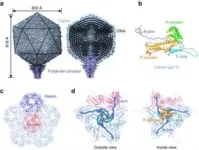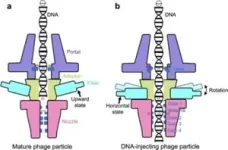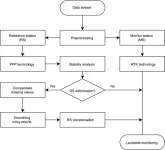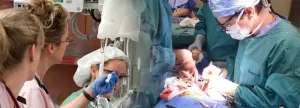(Press-News.org) A research team at the Hong Kong University of Science and Technology (HKUST) has outlined the high-resolution structure of a little-known virus, improving our understanding of viral infection, which could pave the way for more accurate predictions of climate change.
With the help of an advanced technique involving cryo-electron microscopy, they managed to capture images of the virus – the cyanophage P-SCSP1u – at near-atomic resolution in its native form and examined it to see how its different parts fit together. This helped show how different proteins work in the virus and how they interact to make the virus stable and able to infect cells.
Cyanophages, together with their host cyanobacteria, play important roles in marine biogeochemical cycles and control of marine food webs. P-SCSP1u is a representative member of a group of cyanophages called MPP-C, which contain the smallest genomes among cyanopodoviruses and act differently when they infect bacteria. But little is known about their infection process given the lack of high-resolution structural information.
The team, led by Prof. DANG Shangyu, Assistant Professor of the Division of Life Science, and Prof. ZENG Qinglu, Associate Professor of the Department of Ocean Science and the Division of Life Science at HKUST, used an advanced technique – the single-particle cryo-electron microscopy (cryo-EM) – to examine the virus up close, revealing the assembly mechanism of the head and molecular interaction of a part of the cyanophage called the portal-tail complex.
By comparing it to other similar viruses with known structures, the team gained insights into how different components of these viruses have changed over time during the infection process.
Additionally, the study gives us a close-up look at the portal-tail complex, which helps control the virus's DNA. By comparing it to a similar structure in a different virus called phage T7, the study shows how these types of viruses control their DNA. The team also found out about two new parts – a valve and a gate – that help these viruses control how they let DNA in and out of themselves.
“We believe this high-resolution native structure of cyanophage is an important and timely contribution to the field of bacteriophages for the understanding of viral infection,” said Prof. Dang.
Cyanophages are viruses that infect cyanobacteria, which are photosynthetic bacteria that play a crucial role in the Earth's ecosystems. Besides oxygen, they also provide a lot of the food and fuel we consume in our daily lives. These viruses are specific to infect cyanobacteria, and they can significantly impact the population and behavior of these bacteria. These are some of the reasons why understanding how these bacteria grow and die is critical for figuring out how much carbon is in the oceans.
In sunny water, about 5 percent of these cyanobacteria are infected by cyanophages. When infected, these viruses take over the bacteria and make them produce more viruses, akin to turning the bacteria into a virus-producing factory.
These viruses can affect how the bacteria make energy from sunlight by stopping them from using CO2, causing a loss of a huge amount of carbon each year, more than what all the coral reefs, marshes, and sea plants on Earth produce, Prof. Zeng explained.
Figuring out how these viruses work and infect their hosts is crucial, as it helps scientists understand how they affect the bacteria, the oceans, and even the climate, he said.
“Cyanobacteria are highly abundant in Hong Kong waters and play a major role in global CO2 fixation. The global abundance and carbon fixation capacity of cyanobacteria are important for calculating the marine carbon budget. Cyanophages are a major cause of cyanobacteria death. Studying the infection process of cyanophages is important for understanding how they regulate cyanobacterial populations, which is crucial for the accurate estimation of the global carbon budget and for the prediction of climate change,” Prof. Zeng added.
Understanding how these viruses infect can help facilitate the future use of viruses to control harmful cyanobacteria in freshwater as well, he said, adding it would also be important for farming and making sure drinking water is clean.
The study was recently published in the journal Nature Communications. (https://www.nature.com/articles/s41467-023-42258-7)
“It brings us great joy to share our work with the entire scientific community, and we are delighted to learn that our efforts have been acknowledged by a prestigious journal. Our hard work has not been in vain,” Prof. Dang said.
However, a portion of the fiber structure remains unresolved in the team’s current structure due to its high flexibility, but that part is important for the virus to recognize and infect its host.
In the next steps, the team plans to mimic how the virus infects and determine a series of structures to understand the whole process better. This could enable them to figure out the structure of the whole fiber and validate the proposed mechanism as outlined in the paper, Prof. Dang said.
END
HKUST researchers report the high-res structure of a cyanobacterial virus
Paving the way for more accurate predictions of climate change
2023-12-15
ELSE PRESS RELEASES FROM THIS DATE:
Advanced GNSS technique enhances accuracy in landslide monitoring
2023-12-15
In a new study published on 13 November 2023, in the journal Satellite Navigation, researchers from Chang’an University have developed a novel approach using the Precise Point Positioning (PPP) technique combined with a cumulative sum control chart (CUSUM) method. This method enables the analysis of reference station stability and compensates for deformation at monitoring stations.
In the study conducted at the Tengqing landslide in Liupanshui, Guizhou Province, Southwest China, an innovative method was applied, showcasing a significant leap in landslide monitoring using GNSS PPP technology. ...
Risk of death reduces after COVID-19 vaccine but protection wanes after six months – study
2023-12-15
The risk of death from COVID-19 decreases significantly after vaccination but this protection diminishes after six months, providing evidence for continued booster doses, a new study has found.
Researchers from the UK Health Security Agency (UKHSA) analysed more than 10 million cases of COVID-19 in adults between May 2020 and February 2022. Their findings are published in the Journal of the Royal Society of Medicine (JRSM).
The Case Fatality Risk (CFR) - the proportion of cases that resulted in death - was cross-referenced with vaccination ...
The breakthrough is a step towards the development of next-generation magnetic devices that control light
2023-12-15
In a significant advancement in optical technology, researchers from Tohoku University and Toyohashi University of Technology have developed a new method for creating transparent magnetic materials using laser heating. This breakthrough, recently published in the journal Optical Materials, presents a novel approach to integrating magneto-optical materials with optical devices, a long-standing challenge in the field.
"The key to this achievement lies in creating 'Cerium-substituted Yttrium Iron Garnet (Ce:YIG)', ...
How an overlooked study over a century ago helped fuel the Colorado River crisis
2023-12-15
When it comes to the Colorado River, history often repeats itself—but it doesn’t have to.
That’s the take-home message from CU Boulder hydrologist Shemin Ge, who will present a little-known piece of history from the river this Thursday at the American Geophysical Union (AGU) meeting in San Francisco.
The story of hydrologist Eugene Clyde La Rue, Ge said, may help to explain the current water crisis facing many states in the American West.
Ge’s presentation centers around a decision ...
Basic monthly income trial at USC shows promise with significant reduction in homelessness
2023-12-15
Researchers at the Center for Homelessness, Housing, and Health Equity Research at the University of Southern California released an interim report on the first six months of a randomized controlled trial to study the impact of a basic income and social support intervention for 103 individuals experiencing homelessness in Los Angeles County and the San Francisco Bay Area.
Two key findings so far are that participants in the Miracle Money study who received $750 per month were less likely to remain unsheltered and closer ...
New gene therapy could significantly reduce seizures in severe childhood epilepsy
2023-12-15
UCL researchers have developed a new gene therapy to cure a devastating form of childhood epilepsy, which a new study shows can significantly reduce seizures in mice.
The study, published in Brain, sought to find an alternative to surgery for children with focal cortical dysplasia.
Focal cortical dysplasia is caused by areas of the brain that have developed abnormally and is among the most common causes of drug-resistant epilepsy in children. It frequently occurs in the frontal lobes, which are important for planning and decision-making. Epilepsy in focal cortical dysplasia is associated with comorbidities, including learning disabilities.
Although surgery to remove the affected brain malformation ...
Mount Sinai receives $1.3 million from the National Institutes of Health to support program that introduces high school students to virus surveillance
2023-12-15
The Icahn School of Medicine at Mount Sinai has received more than $1.3 million from the National Institute of General Medical Sciences of the National Institutes of Health (NIH) to expand the New York City Virus Hunters program. The program engages high school students from communities historically underrepresented in science in the first large-scale citizen science effort to catalog and map circulating avian influenza and avian paramyxoviruses in New York City’s wild birds. The goal is to track emerging viruses and to prevent future outbreaks.
Wild birds can disseminate infectious ...
UM School of Medicine awarded up to $7.3M from DARPA to drive innovation in trauma triage technology, improve mass casualty response efforts
2023-12-15
In an effort to better optimize the triage of patients during mass casualty events, University of Maryland School of Medicine (UMSOM) researchers are receiving up to $7.3 million in funding from the Defense Advanced Research Project Agency (DARPA) for vital new research. The funding will be used to support a study that will collect data over the next 3.5 years on trauma patients with the aim of identifying and implementing lifesaving advancements in medical triage for large-scale mass casualty incidents.
“The importance of early interventions in trauma is described as the concept of the ‘golden ...
Transportation planning goes virtual
2023-12-15
Freight transportation is a backbone of the US economy — and a significant contributor to US greenhouse gas emissions. In fact, freight accounts for nearly 10% of annual U.S. emissions,ISE Dan Doulet Faculty Fellow and Professor Xueping Li points out. Li and an interdisciplinary, multi-institutional team have been awarded funding from the US Department of Energy to launch a first-of-its-kind, national-scale undertaking to address freight’s impact on climate change — and climate change’s impact on this vital sector.
Funding from DOE’s Advanced Research Projects Agency-Energy (ARPA-E) is highly competitive. “Any ...
Zhou’s new tech has low-income housing covered
2023-12-15
When looking for ways to reduce their carbon footprint, most people think of first of their car, not their house. Surprisingly, however, buildings make up one of the largest energy-consuming sectors of the US economy, accounting for 39 percent of the country’s total energy use.
“Heating and cooling are among the most energy-intensive parts of building operations,” said Associate Professor of Civil and Environmental Engineering Nick Zhou, who leads UT’s Sustainable and Adaptive Built Environment Group in ...
LAST 30 PRESS RELEASES:
Making lighter work of calculating fluid and heat flow
Normalizing blood sugar can halve heart attack risk
Lowering blood sugar cuts heart attack risk in people with prediabetes
Study links genetic variants to risk of blinding eye disease in premature infants
Non-opioid ‘pain sponge’ therapy halts cartilage degeneration and relieves chronic pain
AI can pick up cultural values by mimicking how kids learn
China’s ecological redlines offer fast track to 30 x 30 global conservation goal
Invisible indoor threats: emerging household contaminants and their growing risks to human health
Adding antibody treatment to chemo boosts outcomes for children with rare cancer
Germline pathogenic variants among women without a history of breast cancer
Tanning beds triple melanoma risk, potentially causing broad DNA damage
Unique bond identified as key to viral infection speed
Indoor tanning makes youthful skin much older on a genetic level
Mouse model sheds new light on the causes and potential solutions to human GI problems linked to muscular dystrophy
The Journal of Nuclear Medicine ahead-of-print tip sheet: December 12, 2025
Smarter tools for peering into the microscopic world
Applications open for funding to conduct research in the Kinsey Institute archives
Global measure underestimates the severity of food insecurity
Child survivors of critical illness are missing out on timely follow up care
Risk-based vs annual breast cancer screening / the WISDOM randomized clinical trial
University of Toronto launches Electric Vehicle Innovation Ontario to accelerate advanced EV technologies and build Canada’s innovation advantage
Early relapse predicts poor outcomes in aggressive blood cancer
American College of Lifestyle Medicine applauds two CMS models aligned with lifestyle medicine practice and reimbursement
Clinical trial finds cannabis use not a barrier to quitting nicotine vaping
Supplemental nutrition assistance program policies and food insecurity
Switching immune cells to “night mode” could limit damage after a heart attack, study suggests
URI-based Global RIghts Project report spotlights continued troubling trends in worldwide inhumane treatment
Neutrophils are less aggressive at night, explaining why nighttime heart attacks cause less damage than daytime events
Menopausal hormone therapy may not pose breast cancer risk for women with BRCA mutations
Mobile health tool may improve quality of life for adolescent and young adult breast cancer survivors
[Press-News.org] HKUST researchers report the high-res structure of a cyanobacterial virusPaving the way for more accurate predictions of climate change






